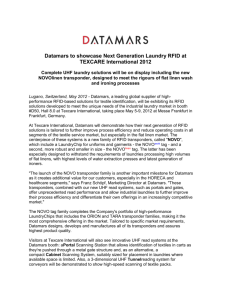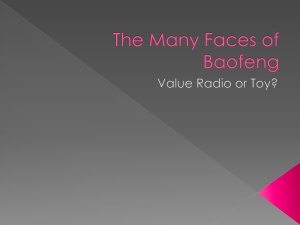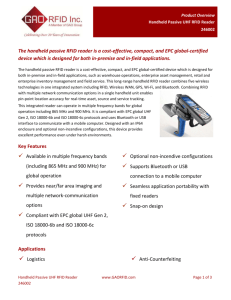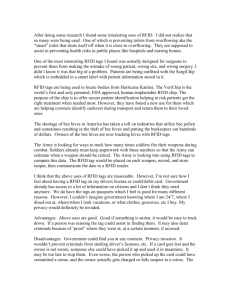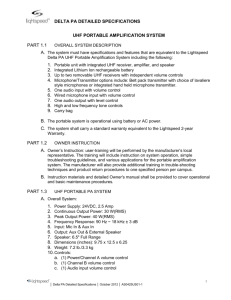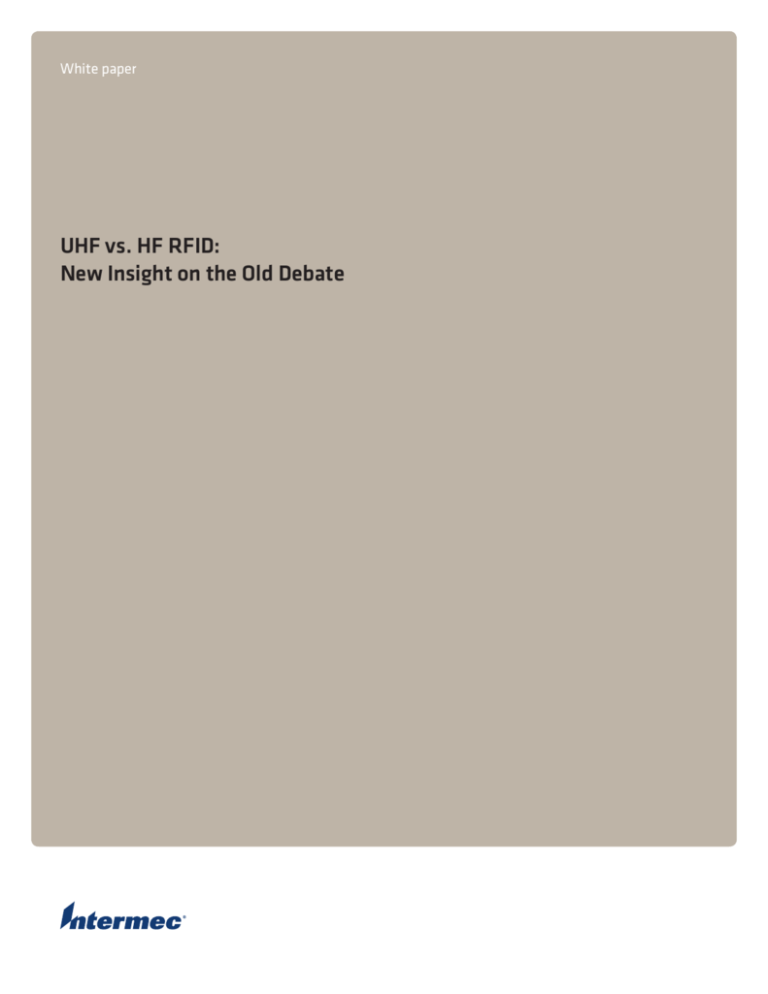
White paper
UHF vs. HF RFID:
New Insight on the Old Debate
It’s time to bring new facts to the old debate as to whether
high frequency (13.56 MHz) or ultra-high frequency (UHF,
which includes EPC Gen 2) RFID technology is best for meeting
business needs. The technologies have changed, therefore
so too should the debate. Specifically, three long-held
assumptions about the technologies need to be reexamined:
• UHF is unusable around liquid and metal
• Short-range reading requires 13.56 MHz
• 13.56 MHz is best for item-level tagging
The capabilities of each technology have changed, therefore so
should biases held about them. For example, 13.56 MHz technology
has historically been advocated for use around liquid and metal,
but today UHF is commonly used in these environments, and UHF
tags have been developed to take advantage of metal to improve
RF performance. Meanwhile, HF is being promoted for some uses
in the supply chain, which is the traditional territory for UHF.
In truth, there is no “best” RFID technology, just as there
is no single bar code symbology that is best for all uses.
Certain RFID frequencies and products are best suited to
specific usage environments. Processes can be developed to
accommodate different technologies, but fitting the process
to the technology is usually a poor approach. When users
understand how RFID will perform in specific environments
and how it can improve their own processes, there is usually
very little debate as to which frequency should be used.
This white paper will bring clarity to frequency considerations by:
• Providing a brief overview of UHF and HF technologies;
• Highlighting new developments and capabilities;
• Presenting examples that illustrate why some long held beliefs and biases are no longer valid, and;
• Explaining why process considerations are key to
selecting the right frequency and getting the most value from an RFID system.
Technology Overview
UHF and HF are general technology categories and there are
many separate protocols within each. HF is more homogenized,
at 13.56 MHz, although there are multiple international
and industry standards for 13.56 MHz RFID. UHF RFID has
been commercialized between 858 and 960 MHz. It too is
supported by multiple standards, including EPCglobal Gen 2.
Tags and readers exchange data by forming a wireless connection.
The connection can be made through either the electromagnetic
(EMF) or RF field, which are both present at all frequencies. The
fields have different ranges and interference resistance. High
frequency RFID technology communicates via the electromagnetic
field. Most UHF systems communicate by radio waves that
provide longer range. Electromagnetic UHF technology is available,
and is referred to as “near field” UHF, which also references
its shorter range in comparison to UHF that uses radio wave
propagation. Unless otherwise noted, when this white paper
references UHF technology (including all references to Gen 2),
it refers to commonly used, RF propagation technology.
The range any RFID tag can attain is primarily dependent
on its wavelength, and therefore its frequency,
because each radio frequency has specific wavelength
characteristics. Antenna size and power output are
other leading variables that impact RFID range.
Frequency aside, the primary difference between HF and UHF
RFID technologies is their read/write range. Because HF and
UHF technologies operate at vastly different frequencies,
there is a big difference in the range they provide. Maximum
range for 13.56 MHz technology is approximately 3 feet, and
maximum range for UHF technology is approximately 30 feet
(10 meters) . Spec sheets may claim better performance,
but these figures are widely accepted as an accurate and
useful reference. Figure 1 provides a quick reference to HF
and UHF technologies and how they are commonly used.
High Frequency (HF) RFID
Ultrahigh Frequency (UHF) RFID
Frequency
13.56 MHz
858 – 930 MHz
Key Standards
ISO 15693; ISO 14443; ISO 18000-3
EPCglobal Gen 2; ISO 18000-6 A, B, C; ISO 17363-67
Minimum Range
Near contact
About 1 inch
Maximum Range
1 meter (3 feet)
10 meters (30 feet)
Typical Uses
Electronic ticketing and fare collection; contactless payment; access control; commercial laundry and garment tracking; sample tracking.
Compliance tagging and other case and pallet ID;
returnable container tracking, work-in-process tracking; asset management; baggage tagging; WiFi-based RTLS.
Figure 1: HF and UHF RFID Technologies at a Glance
13.56 MHz
High frequency 13.56 MHz technology is mature and was one of the
first forms of RFID to be successfully commercialized especially
for access control and contactless payment applications. Tags
and readers in 13.56 MHz systems communicate by coupling in
the electromagnetic field. The frequency, and electromagnetic
communication, provides excellent resistance to common sources
of interference found in commercial and industrial environments.
The well-known drawback of 13.56 MHz technology is its limited
range, which tops out at about 1 meter. Reading speed for 13.56
MHz tags is also relatively slow compared to UHF technology.
There are several widely used protocols and standards for
13.56 MHz technology. The best-known standard is ISO 15693,
which is often used as the basis for presenting 13.56 MHz
technology characteristics and making comparisons to UHF
technology (which itself is most commonly represented by
the EPCglobal Gen 2 protocol). ISO 15963 was developed as a
standard for contactless cards. There are many interoperable
ISO 15693 tag and reader products, which are also used for other
applications, including commercial laundry tracking, library
book management, file tracking and sample identification.
ISO 14443 is another leading 13.56 MHz standard. It was created
for contactless fare collection and other electronic payment
transactions, and is widely used in public transportation systems.
The ISO 18000 series of standards for item management includes
a 13.56 MHz standard, known as ISO 18000-3. This standard was
developed before the ISO 18000-6 UHF series, which includes
EPCglobal Gen 2 (which is equivalent to ISO 18000-6 Part C).
Because 13.56 MHz was one of the first RFID technologies to
be standardized and gain wide vendor support, it was tried for
numerous applications. Some companies that could see the
benefits of contactless identification and high-speed reading
tried using 13.56 MHz for distribution and other supply chain
applications. However, the range limitations of 13.56 MHz
technology didn’t support efficient case and pallet handling
operations, a shortcoming that helped lead to the development
of EPCglobal Gen 2 and other UHF supply chain standards.
These early experiences also stunted RFID development and
adoption. The shortcomings specific to 13.56 MHz technology
for identifying goods in distribution and supply chain operations
led some to conclude that RFID in general was an unreliable or
ineffective technology. This misperception has lingered, despite
being disproved by numerous successful UHF applications.
UHF
Most UHF RFID systems operate in the 858-930 MHz frequency
band and communicate by RF propagation, with maximum
read distances between 20 and 30 feet. Less well-known and
commercialized are near field UHF systems that communicate
in the electromagnetic field and are optimized for short-range
reading. There are numerous UHF standards, most notably Gen
2, which may well be the most widely supported RFID standard.
UHF is the dominant technology for supply chain applications
such as case and pallet tracking and returnable container
identification, and is also widely used for industrial automation,
work-in-process tracking, asset management, inventory
monitoring, forklift monitoring, personal ID, vehicle access
control, document security and other applications.
In early deployments, the UHF systems were susceptible
to interference and performance degradation when used
around liquid and metal. However, the technology has
improved and been adapted to mitigate or eliminate this
interference. For example, some UHF tags have been designed
specifically for use in close proximity to metal and to take
advantage of metal’s conductive properties to enhance RF
performance. Advances in antenna design, reader tuning and
best practices are also overcoming traditional limitations.
New Thinking Needed
Technology maturation is one reason the traditional positions
of the HF vs. UHF debate are no longer valid. According to
conventional thinking, UHF was the best technology for
longer-range applications, and HF was best for short range,
item-level identification or for use around liquid or metal. This
thinking tends to oversimplify the considerations for choosing
the most appropriate business processes and technology,
and may cause potential users to unnecessarily limit the
technology options they consider for their applications.
Rethinking Range
For example, range requirements do not have to dictate whether
UHF or HF technology is used. UHF systems don’t need to be of
the near field variety to work at close range. The same tags that
can be read from 30 feet away can also be read from an inch.
UHF systems can be optimized for various processes and read
distances through the placement and configuration of readers.
UHF is the technology of choice for many work-in-process tracking,
case and pallet identification, check in/check out, inventory
monitoring and security applications because it can provide
the range and coverage users need, but there are no physics or
technological reasons it can’t be used for short-range applications.
When longer read range is required 13.56 MHz technology is
not an option, because it simply cannot match the range of
UHF technologies. Therefore, it is important to consider future
needs and potential expansion of RFID uses when planning
systems. For example, if RFID tagging will initially be involved a
low volume of items that are processed with handheld readers,
13.56 MHz technology would perform just fine. However if
the application could expand to unattended, higher-speed
processing, such as reading items moving on a conveyor belt,
longer-range technology would be advantageous. Regardless of
which frequency is chosen, organizations should strive to select
a single frequency to avoid having to double-tag items (with HF
and UHF tags) to support different processes and applications.
Static Ideas are Outdated
The idea that HF technology is required for use around
metal and liquid is also more of a perception than a
reality. In supply chain applications, UHF is frequently
used to successfully identify cases and entire pallets of
consumer goods with high liquid or metal content.
Items of Contention
Historically, 13.56 MHz technology has been more widely used for
item-level tagging, but recent history suggests performance and
preferences may be tipping toward UHF. Consider the following:
Thailand’s Suvarnabhumi Airport, the newest and largest
airport in southeast Asia, uses UHF RFID tags to identify
airline cargo containers as they enter and exit customs
and holding areas. The containers themselves are metal
and there is a lot of other metal – racks, shelves, material
handling vehicles, etc. – where the RFID tags are read.
• Pan-European retailer METRO Group uses Gen 2 UHF tags
on individual garment hangars in a high-speed system
that sorts 8,000 items per hour at a distribution center.
• Leading U.K. retailer Marks & Spencer reported its UHF-based
item-level tagging program has surpassed 35 million products.
• Boeing announced it will apply permanent UHF tags
to between 1,700 and 2,000 parts on each of its
state-of-the-art “Dreamliner” 787 aircraft.
• Cardinal Health, one of the largest worldwide pharmaceutical
distributors, announced it will apply item-level UHF tags to
pharmaceutical products to satisfy e-pedigree requirements.
• Blue C Sushi, a Seattle kaiten sushi restaurant that
serves customers with plates that pass tables on
a conveyor belt, uses UHF RFID to track individual
plates with read ranges of less than 1 foot.
• UHF is also gaining support for identification documents
and cards, which have traditionally been dominated by
13.56 MHz technology. The U.S. State Department selected
Gen 2 as the standard for its passport card program. UHF
was already used in the NEXUS program to identify and
streamline exit/entry for frequent U.S. border crossers.
Several of these organizations already had Gen 2 UHF systems
in place for case- and pallet-level processing. Using UHF at
the item level enables them to leverage their legacy systems
without having to invest in new tags and readers to create a
separate infrastructure for item-level identification processes.
Hong Kong International Airport provides an example. It is one
of several airports around the world that is using Gen 2 RFID
to identify, sort and route passenger baggage. The layout and
configuration of legacy material handling systems – which
contain a lot of metal – often requires readers to be mounted
quite close to tagged bags moving by at high speeds.
Reliable UHF performance in the presence of these materials
extends to the item level – in the pharmaceutical industry,
UHF tags are used to identify liquid drugs in foil packaging.
Item-level UHF tags are used for packaging validation, product
authentication and other applications, some of which require
dozens or hundreds of items to be read simultaneously.
Another example illustrates how much technology has improved
to make UHF a reliable option in industrial environments. After
testing UHF and HF technologies, Boeing chose to identify
flight-critical aircraft parts with UHF tags to streamline
maintenance and pre-flight inspection processes. Tagged aircraft
parts are often read at closes ranges where metal and other
potential interference sources are present, and Boeing has
used metal-mount UHF tags designed specifically to identify
metal objects – a product option that was not available when
many long-held opinions about UHF capabilities were formed.
These few examples illustrate how RFID technology and
its applications are evolving, and why some strongly-held
beliefs about its limitations are no longer true. Planning
based heavily on the limitations of technology can overlook
the importance of developing processes that create business
value before selecting a technology. RFID technology should
support the desired process, not the other way around.
Plan for Processes, Not Technology
When used as a straight replacement for bar coding, or strictly
to meet compliance mandates, RFID is rarely cost effective. As
referenced previously, RFID was initially considered a failure for
supply chain operations because of the performance of 13.56
MHz-based applications. Companies could successfully read 13.56
MHz tags on cases or cartons, but only at ranges comparable
to (and even shorter than) their legacy bar code systems.
Therefore efficient new processes could not be developed.
Today many bar code processes involve bringing the bar coded
object to the reader, either by conveyor, forklift or manual
handling. These processes usually require some labor to handle
objects (whether they be samples, WIP assemblies, totes
or shipping containers) and orient the bar code for proper
presentation to the reader. RFID, with its ability to read tags
without a direct line of sight and to identify multiple objects
simultaneously, can be used to eliminate much of the labor now
required. The more coverage the RFID system provides, the less
control over object location is required – and therefore the more
potential to create labor-free processes . This is an important
advantage RFID provides over bar code technology. For example,
bar code ID often limits the performance of conveyor systems,
because they often must run considerably slower than their
top speeds so bar code readers can identify passing objects.
Users are at risk to be disappointed if they choose a technology
without first carefully planning processes that will return
business value. It is also important to consider future needs
so that a single RFID infrastructure can support multiple uses.
For example, if an initial RFID project for WIP tracking could
be expanded in the future to track inventory and shipments,
it would be wise to specify UHF technology, which can satisfy
requirements for short-range reading at assembly stations
and long-range storage, shipping and receiving processes.
Conclusion
There is no debate that the UHF and HF varieties of RFID
are mature, standardized and widely supported, and that
they provide reliable, excellent performance when used
appropriately. What is debatable are the best usage scenarios
for each technology. This decision doesn’t need to be confusing.
What’s most important is to develop a solid understanding
of business needs and how RFID processes can be beneficial.
Create the working conditions and design the changes that
are best for your business, not for a specific RFID technology.
When users know what they need, there’s little debate
as to what technology is best suited to providing it.
Intermec, an RFID pioneer, has extensive experience in helping
organizations understand their RFID needs and opportunities
and in designing and implementing successful systems.
Intermec Inc. (NYSE:IN) develops, manufactures and integrates
technologies that identify, track and manage supply chain
assets. Core technologies include RFID, mobile computing and
data collection systems, bar code printers and label media.
The company’s products and services are used by customers
in many industries worldwide to improve the productivity,
quality and responsiveness of business operations. For more
information about Intermec, visit www.intermec.com or call
800-347-2636. Contact Intermec Investor Relations Director
Kevin McCarty at kevin.mccarty@intermec.com, 425-265-2472.
North America
Corporate Headquarters
6001 36th Avenue West
Everett, Washington 98203
Phone: (425) 348-2600
Fax: (425) 355-9551
South America & Mexico
Headquarters Office
Newport Beach, California
Phone: (949) 955-0785
Fax: (949) 756-8782
Europe/Middle East &
Africa Headquarters Office
Reading, United Kingdom
Phone: +44 118 923 0800
Fax: +44 118 923 0801
Sales
Toll Free NA: (800) 934-3163
Toll in NA: (425) 348-2726
Freephone ROW: 00 800 4488 8844
Toll ROW: +44 134 435 0296
Asia Pacific
Headquarters Office
Singapore
Phone: +65 6303 2100
Fax: +65 6303 2199
OEM Sales
Phone: (425) 348-2762
Internet
www.intermec.com
Worldwide Locations:
www.intermec.com/locations
Customer Service and Support
Toll Free NA: (800) 755-5505
Toll in NA: (425) 356-1799
Media Sales
Phone: (513) 874-5882
Copyright © 2007 Intermec Technologies Corporation. All rights reserved.
Intermec is a registered trademark of Intermec Technologies Corporation. All other
trademarks are the property of their respective owners. Printed in the U.S.A.
611861-01A 10/07
In a continuing effort to improve our products, Intermec Technologies Corporation
reserves the right to change specifications and features without prior notice.

